The return of the UEFA Champions League this week sees Liverpool host Atletico Madrid at Anfield, with Liverpool looking to overturn a 1-0 loss from the first leg. Liverpool struggled to create chances in the game, but weren’t poor in terms of tactics and got into some good areas where their final pass or technical ability on the night let them down. However, one area I feel Liverpool will have been very disappointed with was their work from set-pieces, with them struggling to create a chance from these areas. With Atlético employing a strict man to man approach from corners, I feel as though Liverpool have the chance to exploit the Spaniards from set-piece situations, and within this tactical analysis, I have identified key areas of weakness in Atlético’s set-pieces, which Liverpool could look to exploit. Therefore, you could treat this as an opposition analysis on Atlético’s set-pieces, and it, therefore, should give you an insight into what clubs look for.
Use of blockers to disrupt man-marking
With man-marking relying on the defenders matching the movements of the attackers, using blockers to prevent the defenders from doing this is extremely effective. We can see a few examples here of Atlético’s set up being exploited with some clever blocking routines, and later in the article, I’ll add some of my own based on all of the trends in this article.
Here, we see the target player highlighted, with his marker straight in front of him looking to match his run. The player next to him (number 18), is unmarked and looks to act as a blocker to both disguise who the real target player is and to also then free this target player.

We can see the target player makes a quick movement to the left, while number 18 now moves into the path of the marker, giving this player a free run at goal. The player moves into this space highlighted which is left unoccupied and wins a free header which goes back towards the back post.

We saw Liverpool try and exploit this idea in the first leg, as we can see in this example below. Liverpool form a block of three players against Atlético’s two markers, with Virgil Van Dijk staying deeper than the other two players who act as blockers. Fabinho also moves a player onto the goalkeeper, keeping them further away from the target area.

We can see Gini Wijnaldum here stays to block his marker’s recovery run to compete with Van Dijk, and so Van Dijk gets a free run at into a good space, with Roberto Firmino peeling off at the back post to win a flick on if Van Dijk chooses this. The positioning of Fabinho also helps to create a deeper offside line, which increases Firmino’s chance of scoring.

Liverpool look as though they did their homework on that previous routine, with a very similar routine below occurring. Here Atlético have better coverage of the deeper near post area, with a player occupying it this time. This is because there is no deeper short option offered from the attacking team, whereas you notice Liverpool have pulled a player short and attracted this player.
The opposition’s blockers actually do not a great job here, with the visibility of the furthest man in this cluster not hindered too much it doesn’t seem, but Atlético still concede a header in a similar area.

We can see another routine here from the same game, where space is created through the positioning of players and Atlético adapting their shape to this. The furthest man again is the target player, and number 18 moves into the path of his blocker and gives the player a free run.

We can see throughout all of these routines mentioned so far, Atlético’s shape is different for virtually every one due to its dependence on the opposition, and therefore you can create different spaces throughout the game.
Short corner weakness
In the same way that diversion runs around the box can create space for your teammates by moving the opposition, making diversion runs forward towards the goal can also have a helpful effect in offense. By players making runs towards the goal despite the ball not being delivered into the box, you can set the opposition offside line, and Atlético’s set up can be exploited in this way as we can see in the examples below.
We can see here Valencia don’t actually use the routine, but the situation is still created. The ball is played short to the edge of the box (if this is done from a deep runner it’s harder to defend), and the long wall of Valencia players move forward towards the goal, with Atleti dropping with them to defend. We can see the corner taker is actually in an excellent position when the ball is played to receive the ball back and drive into space, with Atleti disorganised as a team.

We can see here, with no real diversion runs to push the offside line back, Atleti are still in a poor position depth-wise, and the corner taker can receive the ball back and cause them issues. As I’ll come onto at the end of the article with the routine section, if you can combine this with Fabinho’s positioning on the goalkeeper, then suddenly this is a lot easier.
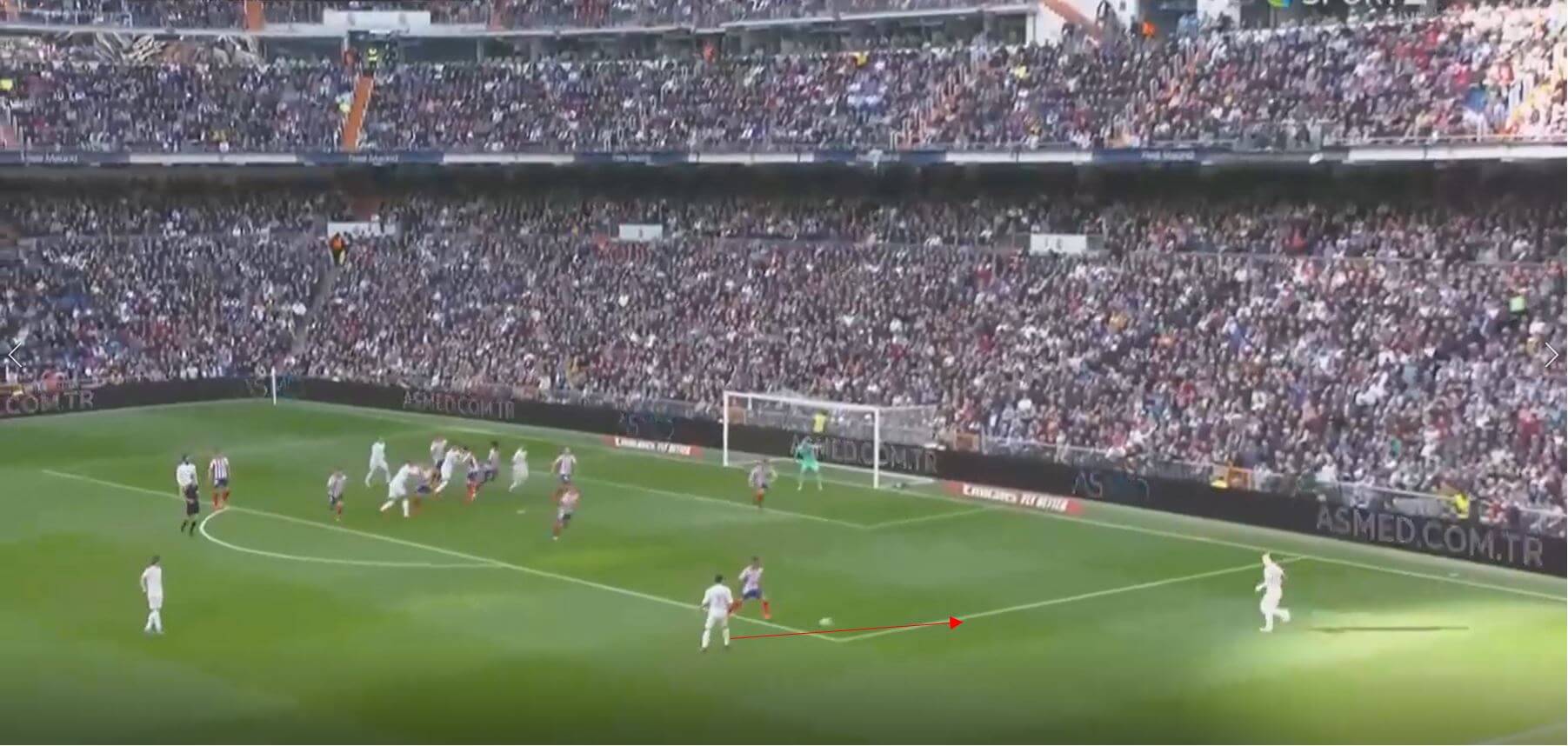
Again, it’s something Liverpool are aware of, trying this routine in the first leg, Atlético push out more effectively, but again there is still some deficiency with the line not exactly perfect. Alexander Arnold is onside and can get into a dangerous position to deliver a cross.
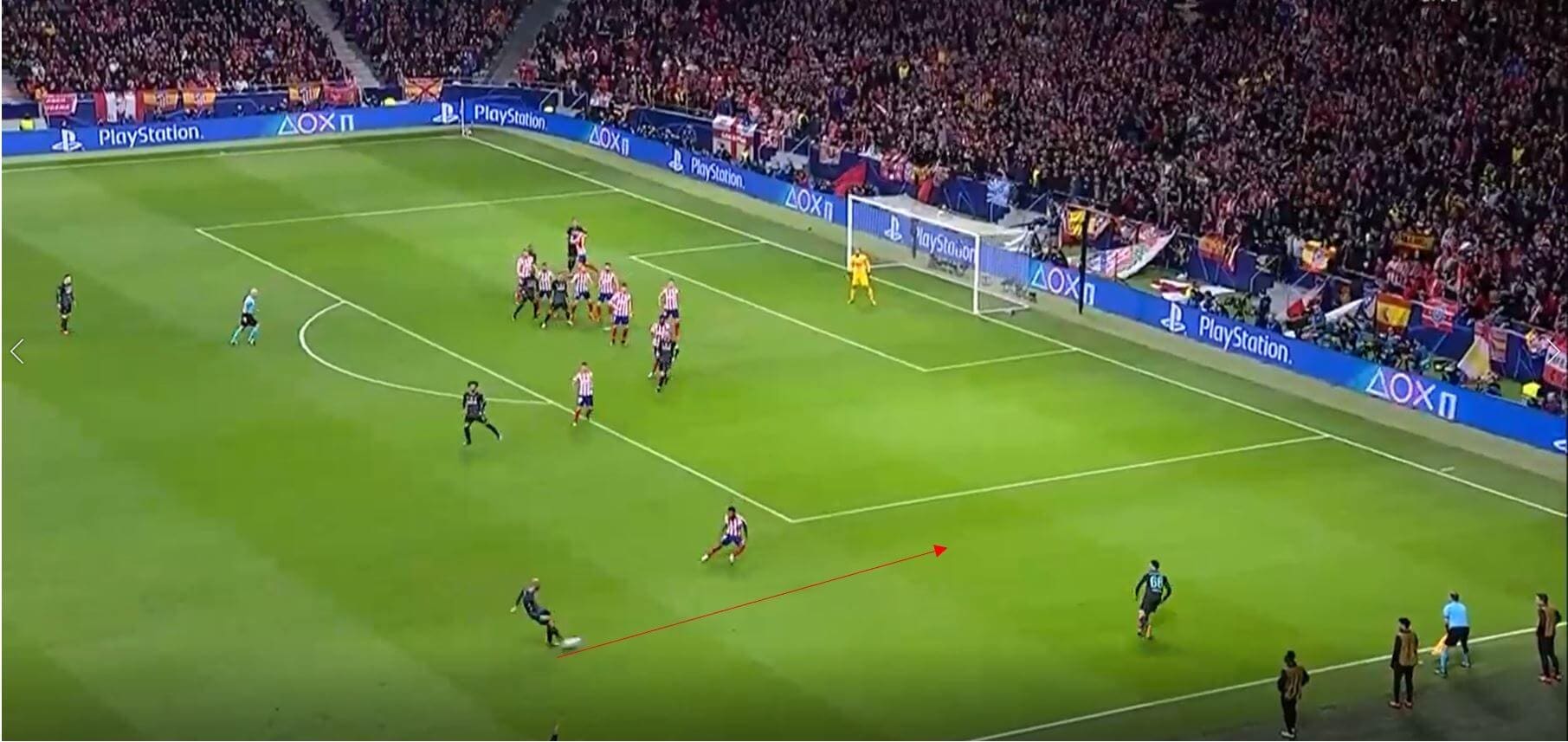
Peeling off the back post
As you can see by now, depending on where you position your players, there are a number of different areas in which you can try to exploit. In this next trend, we have seen teams have some success targeting the back post with the same movement. I also covered this in the preview from the first leg.
A player stands behind the goalkeeper while a player at the back post occupies a marker, seemingly cutting off this area for a delivery. Valencia’s shape doesn’t look particularly dangerous.
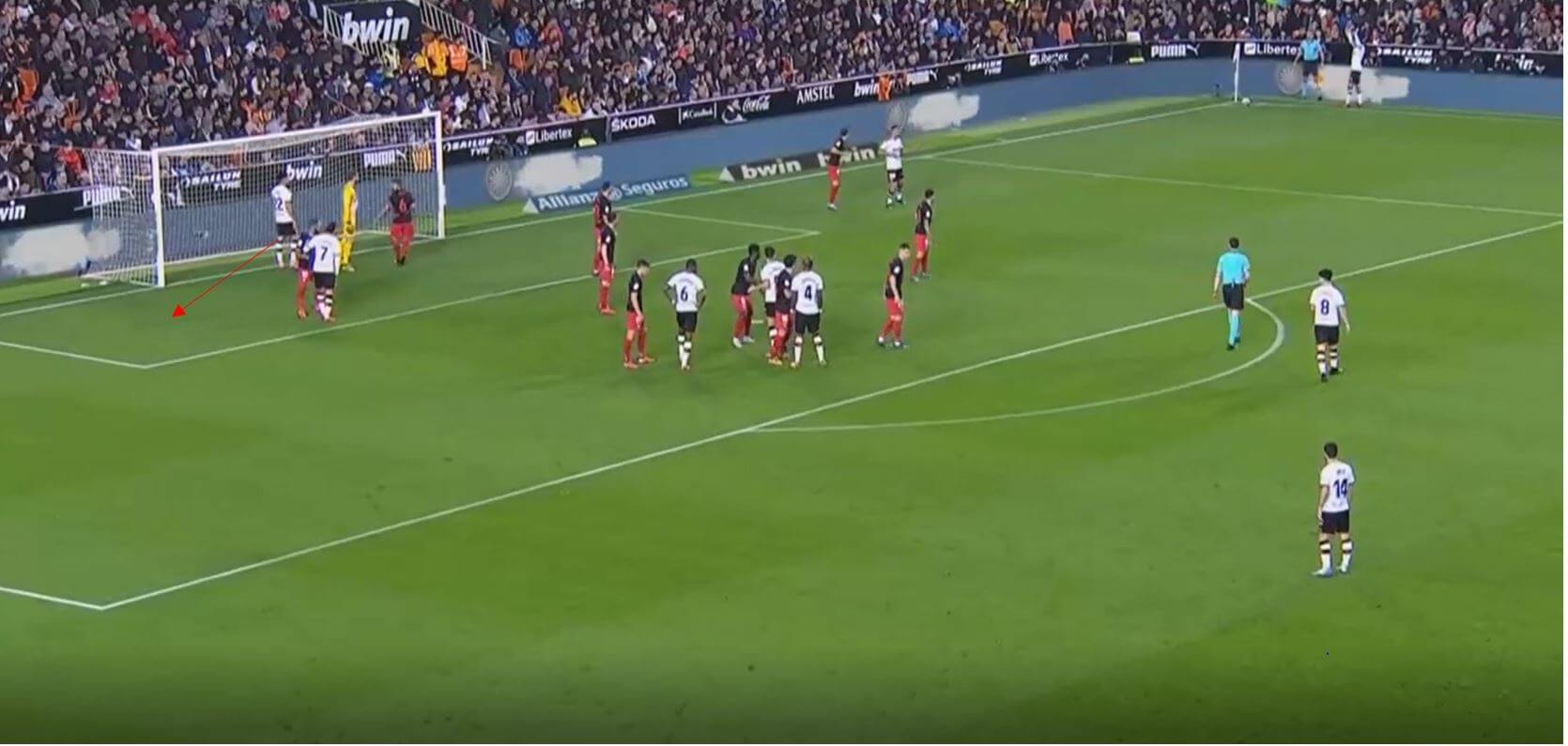
The player at the back post makes an early run which drags the marker away, and the player once stood behind the goalkeeper moves back into this space unmarked. They can then deliver a cross and score, with the deepest central players having made well-timed runs into the danger area.
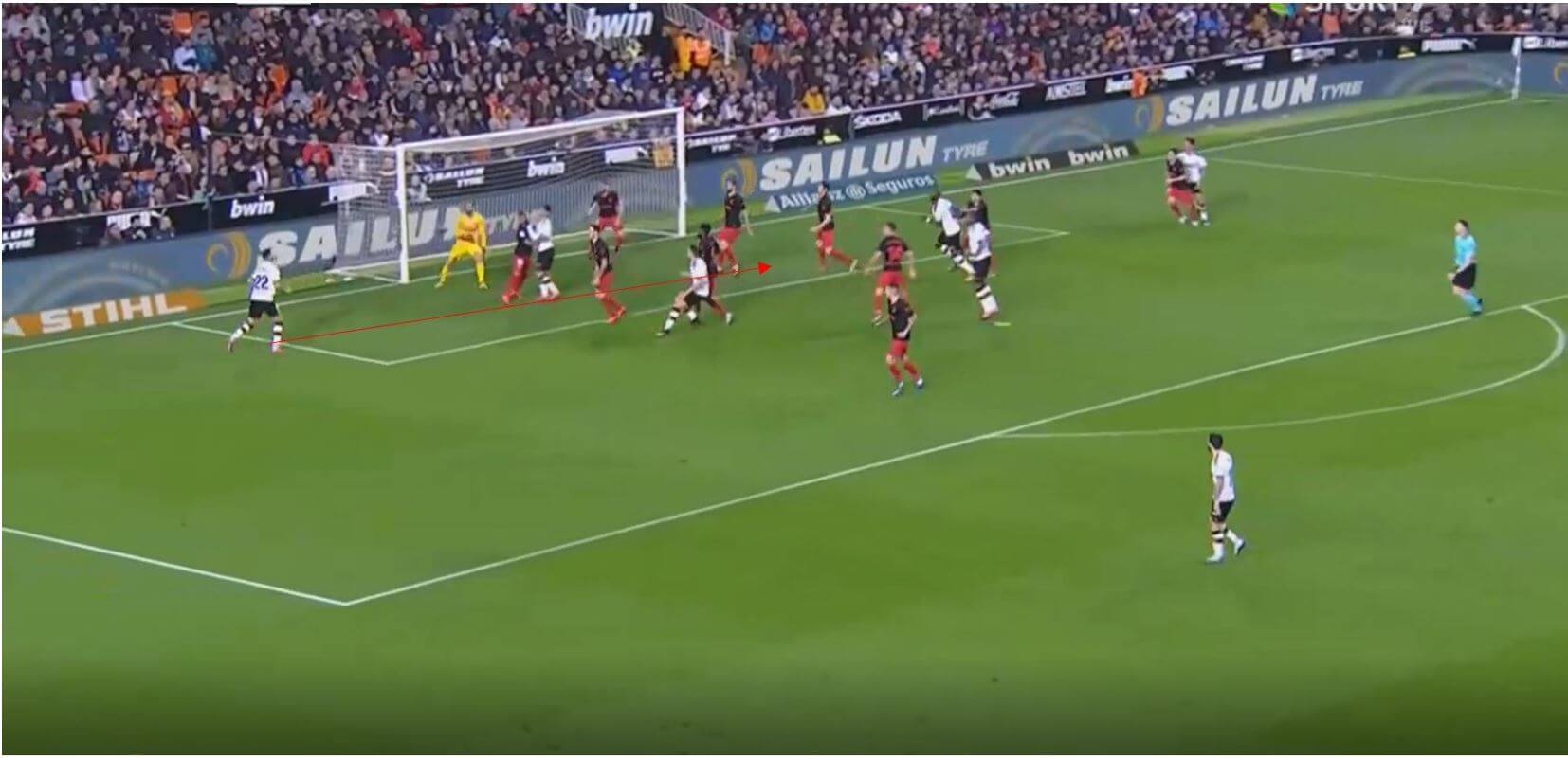
We can see a similar situation here, with a player furthest back moving towards the underloaded back post, which is underloaded because the front post has been overloaded, therefore players follow. This follows the basic principle of overloading one area to create space in another less loaded area.
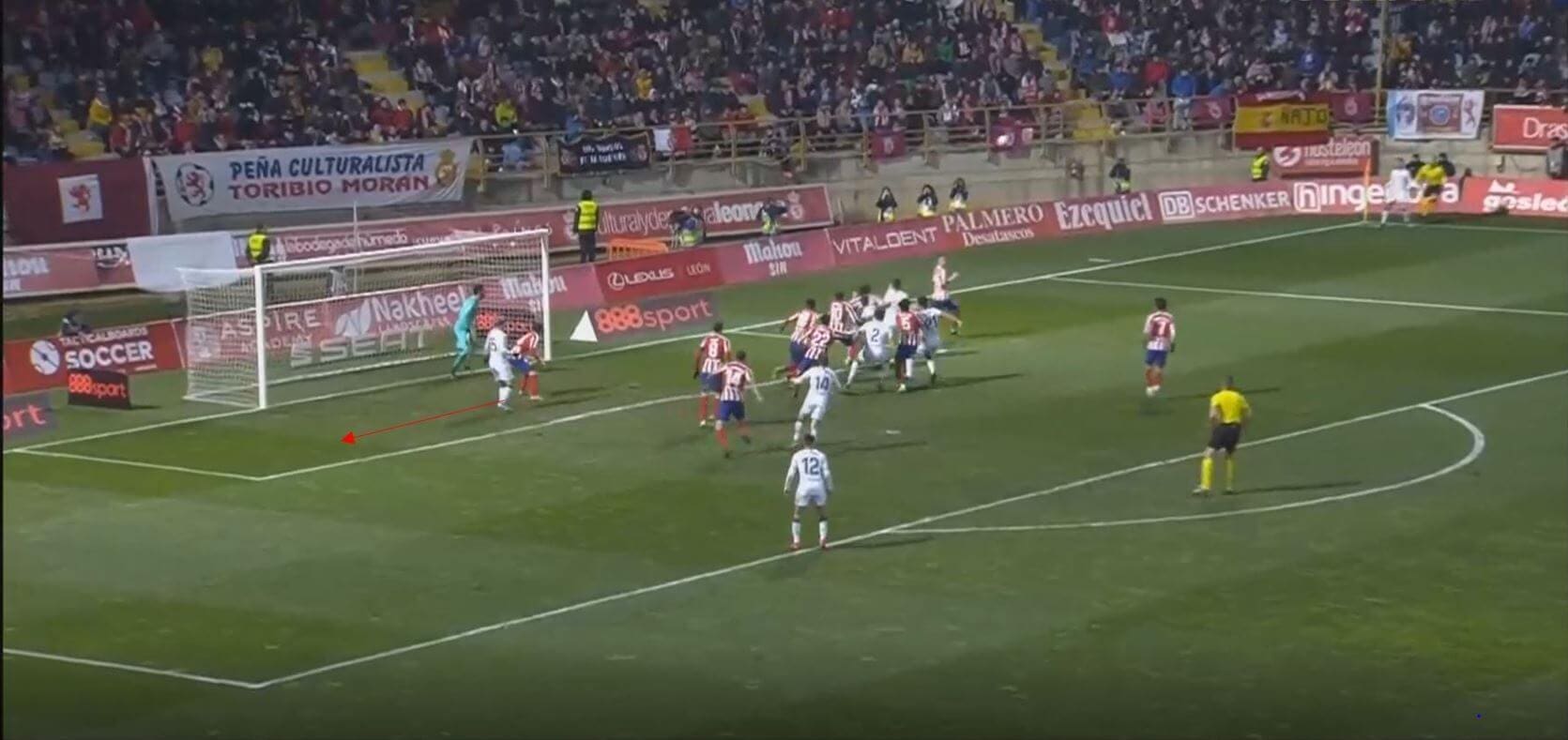
Again the player is able to peel off at the back post, and the defence does a poor job of winning the first header, and so a free header is given at the back post which the opposition don’t take advantage of.
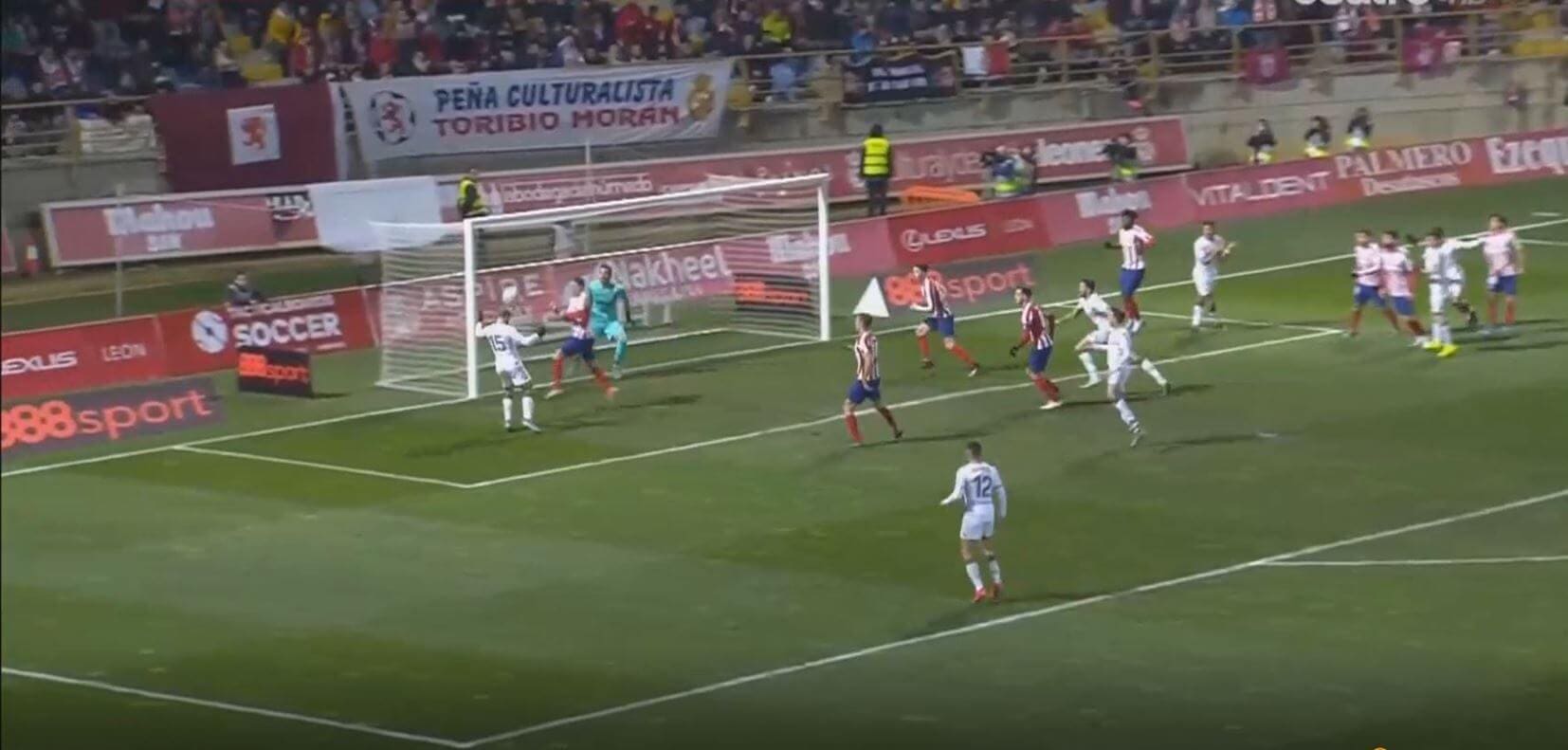
Free kick weaknesses
One weakness I have found from analysing Atlético’s free kicks is a weakness at the near post area when positioned deeper with the ball in wide areas. We can see various examples of this below with this first example showing a false run failing to be dealt with.
The player makes an initial run into this near post area which is poor occupied and is followed slowly, leading to this false player gaining space on his marker.
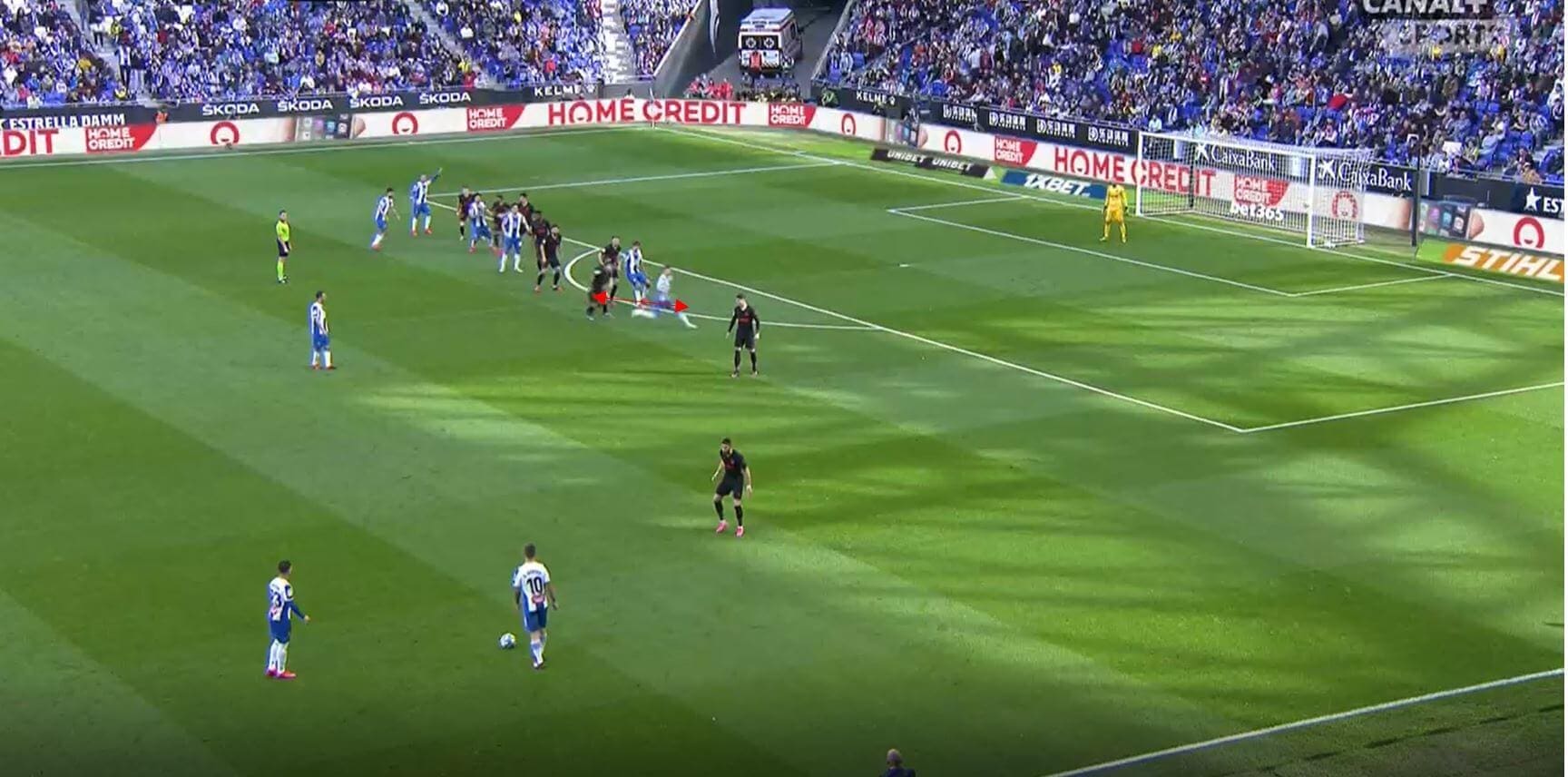
The player making the false run then stops, but Atlético then also stop, creating further separation for this player and the ball can be delivered into this area. As you will see as this section continues, Atlético’s players occupying this near area often take up a poor body position.
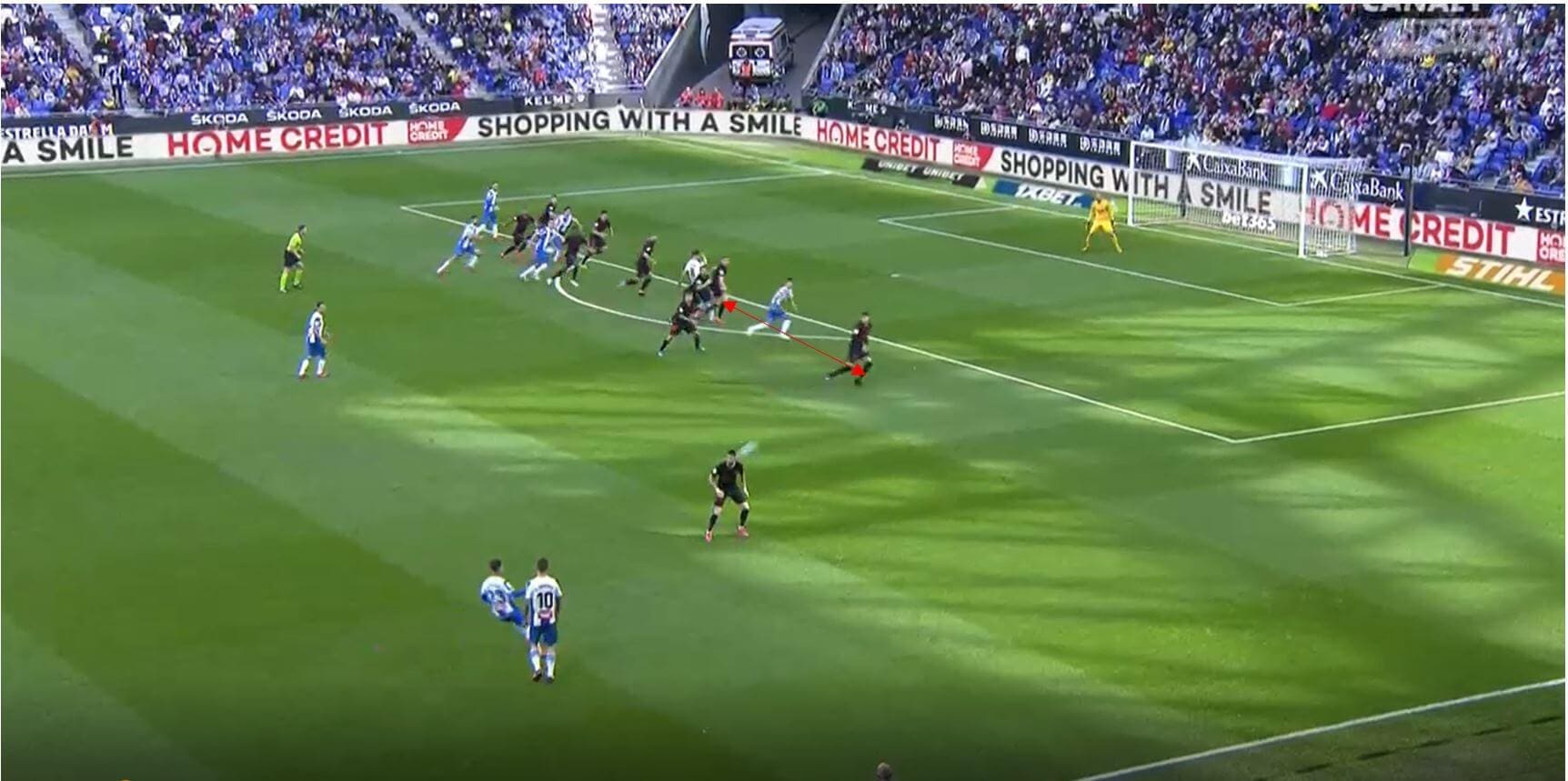
We can see this weakness here, with again the ball played into this area, and the player responsible for the player in this area flat-footed and can therefore not move quickly to match the run of the opposition. Atleti’s offside line is also pretty poor, arcing out and dropping deeper with the ball not being played yet, allowing this near post run to stay onside.
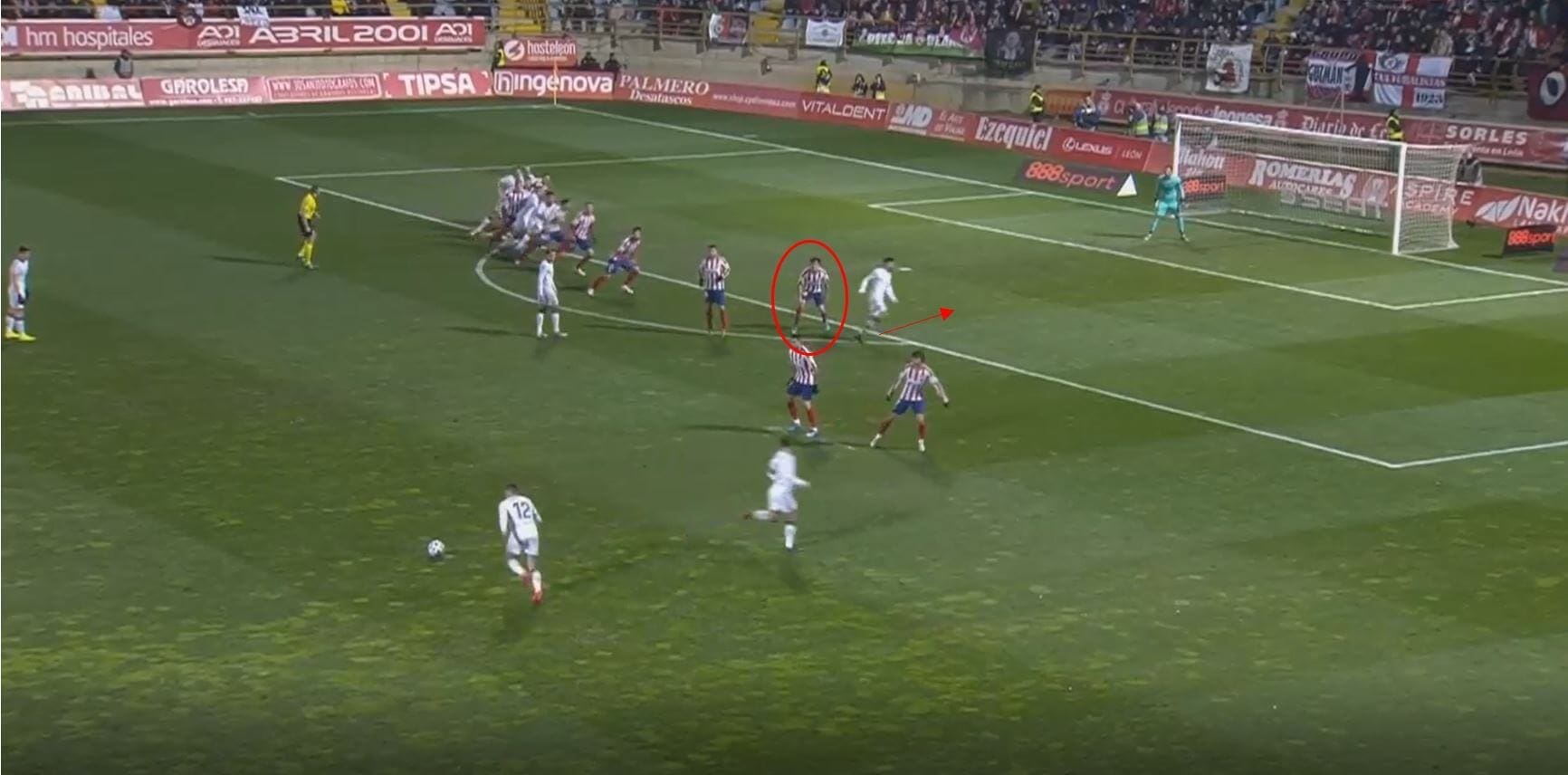
We can see again here, the defender nearest to this area is flat-footed and gets low to the ground, slowing himself down and allowing a player to gain space on him in this area and score. I believe these types of situations represent a massive opportunity for Liverpool to hurt the Spaniards and will be vital in their attempts to win the tie.

Potential routines
The following routine could be used to try and exploit this weakness at the front post, with a player waiting near the closest player to the near post and eventually acting as a blocker. Once the ball is played, the near post player can make a narrow movement in front and in the direction of the near post defender, while the player positioned behind the blocker can make a run into the near post area. Alternatively, the near post player could make a wider run, with the deeper player then running into the space left.

We can see another potential weakness here, with a large separation being created by the opposition positioning a player in the wide area. There is then potential to play the ball through.
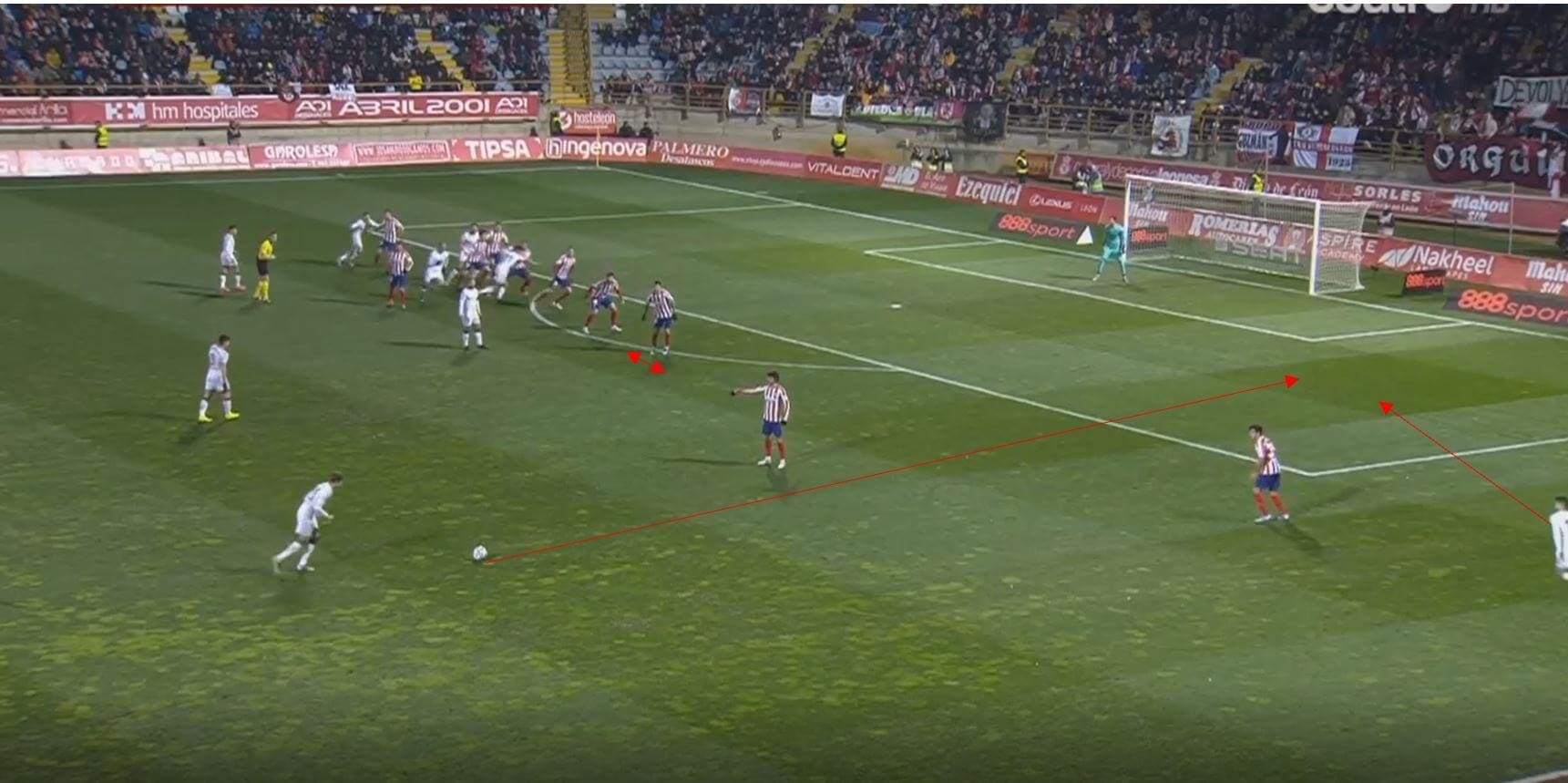
Wolves recently used a similar routine against Bournemouth, with one clever adaptation being the positioning of a player in an offside position. By positioning the player here, he is able to get a head start on the defenders, and can, therefore, reach the ball before defenders without being offside.
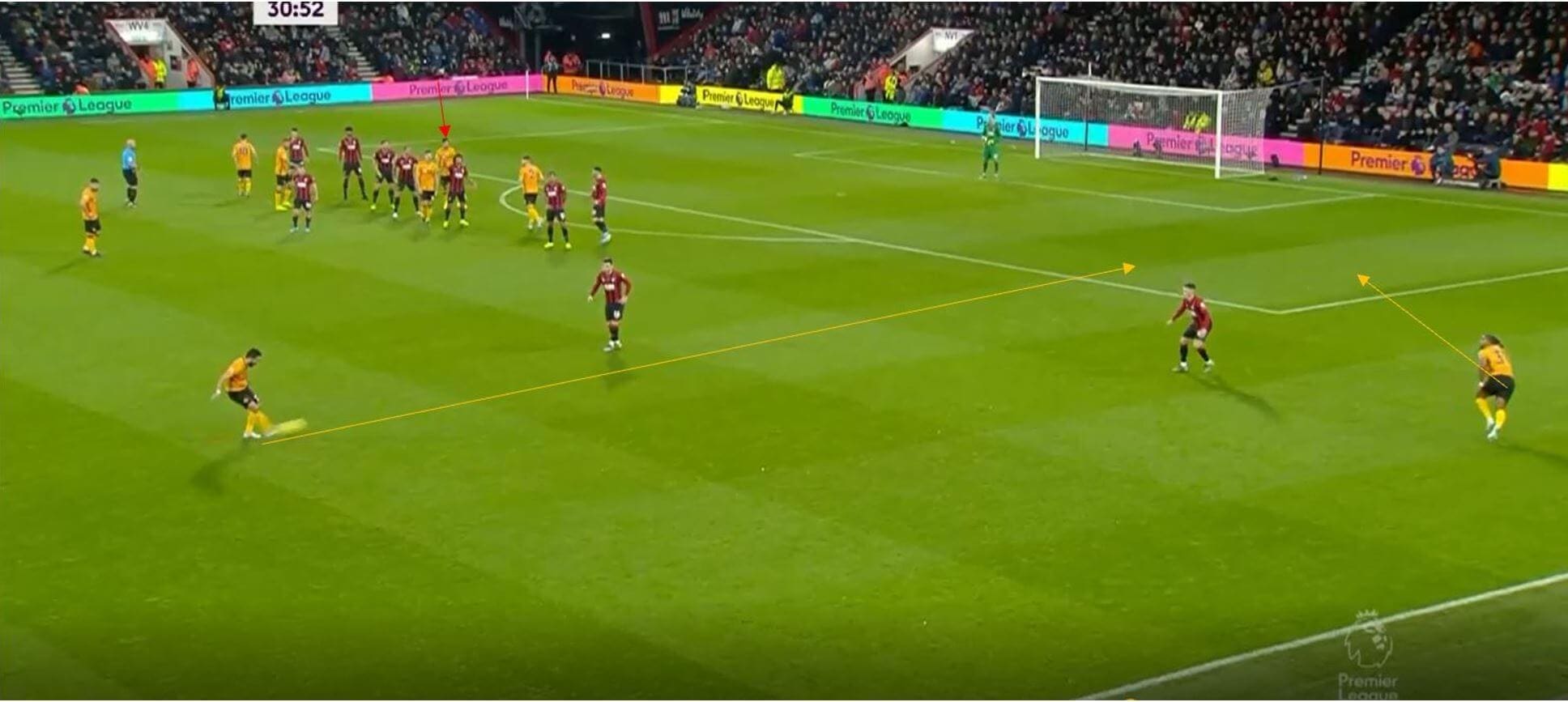
Corner routine
There are a vast number of corner routines which could be developed, with multiple variations on blocking depending on the direction of the runners. In this routine, Liverpool use a near post overload to exploit the back post area. A short option is taken to reduce the number of Atleti players in the area, therefore meaning that they have to commit more players closer to the near post to deal with the overload. The ball will be delivered to the back post, with the two players in this area performing a scissor movement and crossing over each other. The positions of the Atletico defenders provide some blocking while the crossing movement also does, and as I’ve shown throughout this analysis, I wouldn’t expect Atleti to deal with this in a short period of time.
Again alternatively (highlighted in green), a third player could peel off towards the back post, with the two players providing a block for a deeper area, where a player could potentially shoot on goal, perhaps Mohamed Salah would be most suitable due to being left-footed.

Corner taken quickly?
The final trend I’ll comment on in this set-piece analysis is Atleti’s lack of concentration at times, and Liverpool may, as a result, look to keep the tempo high and catch them off guard, as they did famously to Barcelona at Anfield.
We can see in this first example here, the opposition have space to receive the ball, and the corner taker is over the ball, but Atleti’s players are still organising and not concentrating on the ball or the delivery. With quick thinking, the opposition could have fashioned a chance with a cutback.

We can see in this example, Atleti simply allow a player to ghost into the box, and with all players occupied on markers, there is no adjustment made.

In this final example, we can see Vidal has already started his run on the edge of the box, clearly looking to run in behind. Lionel Messi looks at Vidal and begins his run-up, but the defender remains flat-footed and doesn’t react, and the ball is played in behind him where Barcelona score from the resulting cross.

Conclusion
By no means am I suggesting that all of the routines or weaknesses within this analysis will be exploited in the game, and as always with set-pieces, a lot depends on the delivery on the night. Nevertheless, I believe Liverpool will have focused on set-pieces as a way to score goals in the game, and through watching every Atletico Madrid corner and free-kick against since December, these are the trends I have picked out and would look to use.





Comments